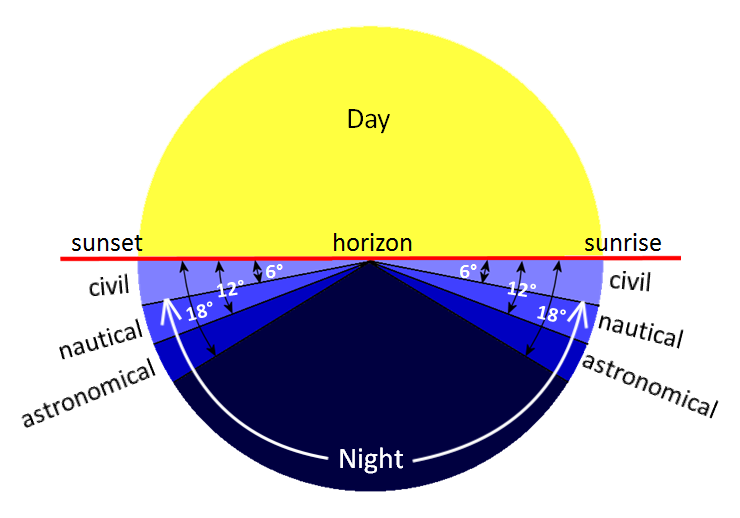Sunrise Sunset Calculator
Calculator Use
Find sunrise and sunset times for any location. Enter latitude and longitude and select the time zone for the location.
This sunrise sunset calculator finds the time of day for sunrise, sunset, dawn and dusk. Just input latitude, longitude and time zone or UTC offset.
You can customize the output to display day length and also the change in day length from day to day. A positive change in day length means days are getting longer. Days get longer between winter solstice and summer solstice.
A negative change in day length means days are getting shorter. Days get shorter between summer solstice and winter solstice.
You can also show solar noon or dawn/dusk twilight in terms of civil, nautical or astronomical twilight. Learn more about the different types of twilight below.
How to Enter Latitude and Longitude
Enter degrees and minutes as whole numbers, or degrees and minutes as a decimal number. If you enter degrees as a decimal number you should leave the minutes field blank.
If your location is west of the Prime Meridian you should enter a negative longitude. If your location is south of the equator you should enter a negative latitude.
Examples of Lat Long GPS Coordinates
Using the geographical coordinates for Portland, Oregon in the US, enter them into the Sunrise Sunset Calculator like this:
- latitude 45° 31' and longitude -122° 41' or
- latitude 45.52° and longitude -122.68°
Find Coordinates for any Geographical Location
Use Google Maps to find your location, for example, Portland, Oregon.
- Right click a specific point on the Google map and you will see the latitude and longitude coordinates, for example 45.51421, -122.68462.
- This stands for latitude 45.51421 (north of the equator) and longitude -122.68462. The negative longitude means the location is west of the Prime Meridian which is at 0° longitude.
- Click on the coordinates to copy them.
Be sure to set the time zone for your GPS lat/long coordinates. For Portland, OR for example the time zone is UTC -08:00 when in Pacific Standard Time PST. If you're in a location that is in daylight savings time be sure to add an hour to the offset. So in Pacific Daylight Time PDT, Portland's UTC offset will be one hour ahead at UTC -07:00. Or you can click on the box for "In Daylight Savings" and the calculator will automatically add one hour to the output times to correct for daylight savings time.
Find Your Time Zone and UTC Offset
Wikipedia provides resources to look up UTC offsets:
- List of UTC offsets
- Look up UTC offsets for time zones including information on daylight savings time
Astronomy Definitions for Sunrise Sunset Times
Sunrise
Sunrise is defined as the moment in the morning when the upper edge of the sun is in line with the horizon at zero degrees (0°).
Sunset
Sunset is defined as the moment in the evening when the upper edge of the sun is in line with the horizon at 0°.
The Three Types of Twilight
Twilight is the time when the sky is somewhat light but the sun is not above the horizon. You can see twilight in the morning at dawn, and in the evening at dusk. There are three types of twilight: civil, nautical, and astronomical.

Source: https://www.weather.gov/lmk/twilight-types, last accessed on 2023-10-29
Civil Twilight, Dawn and Dusk
Twilight occurs twice a day, once at dawn and once at dusk. Civil twilight is defined as the moment when the center of the sun is 6° below the horizon, up until sunrise. This is what people generally mean when they say "dawn" or "dusk".
Dawn
The moment in the morning when the center of the sun is at a depression angle of six degrees 6° below the horizon. Morning civil twilight occurs from civil dawn until sunrise.
Dusk
The moment in the evening when the center of the sun is at a depression angle of six degrees 6° below the horizon. Evening civil twilight occurs from the point of sunset through civil dusk.
Nautical Twilight, Dawn and Dusk
Nautical twilight occurs when the center of the sun is 12° below the horizon.
Nautical Dawn
Nautical dawn is defined as the moment in the morning when the center of the sun is at a depression angle of twelve degrees 12° below the horizon. Nautical twilight occurs from nautical dawn until the point of civil dawn.
Nautical Dusk
Nautical dusk is defined as the moment in the evening when the center of the sun is at a depression angle of twelve degrees 12° below the horizon. Nautical twilight occurs from the point of civil dusk until nautical dusk.
Astronomical Twilight, Dawn and Dusk
Astronomical twilight occurs when the center of the sun is 18° below the horizon.
Astronomical Dawn
Astronomical dawn is defined as the moment in the morning when the center of the sun is at a depression angle of eighteen degrees 18° below the horizon. Astronomical twilight occurs from astronomical dawn until the point of nautical dawn.
Astronomical Dusk
Astronomical dusk is defined as the moment in the evening when the center of the sun is at a depression angle of eighteen degrees 18° below the horizon. Astronomical twilight occurs from the point of nautical dusk until astronomical dusk.
Solar Noon or Transit
Solar noon is defined as peak of the sun's transit, which is the moment when the sun is halfway between sunrise and sunset. Solar noon is not necessarily the same as noon time of the day.
Additional Reading on Sunrise Sunset Times
Horizon, Rise, Set, Twilight Definitions and Computational Details from the Department of Physics & Energy Science, University of Colorado at Colorado Springs
Twilight Types from the National Weather Service